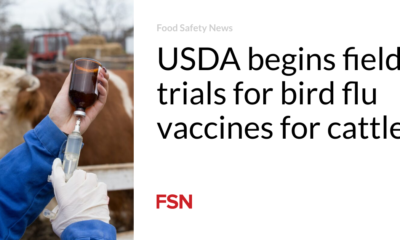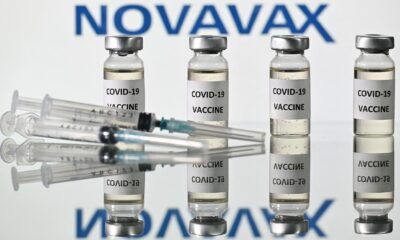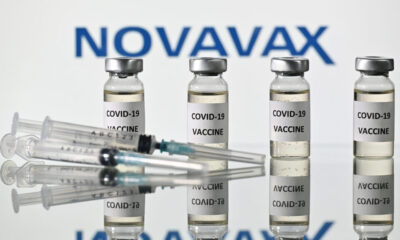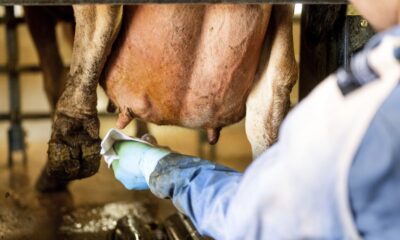Health
Bird flu vaccine for cows is gaining interest
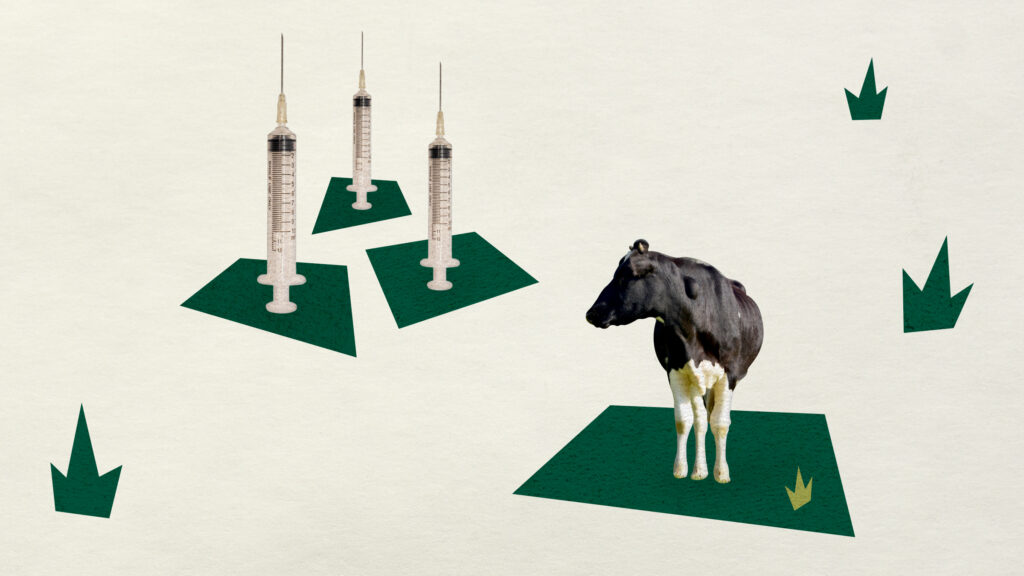
With the number of U.S. dairy herds infected with H5N1 bird flu rising almost daily, fears are growing that the dangerous virus cannot be driven out of this species. That belief is amplifying calls for the development of flu shots for cows.
Multiple animal vaccine manufacturers are reportedly at work trying to develop such products. And the U.S. Department of Agriculture is eagerly encouraging the effort, detailing in a notice last week what kinds of evidence would be needed to win licensing approval for cow vaccines.
But a number of scientists question whether investing too heavily in this strategy is a wise approach at this point, given that there remain many outstanding questions about whether vaccinating cows would be an effective way of stopping spread of the virus in cattle in the first place. Some wonder whether farmers will be willing to absorb the costs of vaccines to prevent an infection they don’t currently view as a serious threat to their operations, or whether they would agree to the stringent post-vaccination surveillance that must go hand-in-glove with any attempt to use vaccines to solve this vexing problem.
To date dairy farmers have, in large measure, refused to cooperate with efforts to chart how deeply the virus has infiltrated U.S. herds, seeing the possible stigma of admitting they have H5N1-infected cows as a greater risk than the virus itself.
“Despite the USDA’s program to compensate farmers for production losses and their and other agencies’ efforts to incentivize more testing of cows and people at-risk, distribute [personal protective equipment], etc., there doesn’t seem to be widespread enthusiasm,” said Angela Rasmussen, a virologist at the University of Saskatchewan’s Vaccine and Infectious Disease Organization in Saskatoon, Canada. “That makes me wonder how willing producers would be to vaccinate their entire herds even if a vaccine were available, especially if it costs them any money at all. For large herds, this could mean a substantial investment.”
Rasmussen is one of a number of experts STAT spoke to who are not convinced cow flu shots are the answer to this dilemma. The need to stop transmission of the virus in cows is pressing — more, really, for us than for the animals themselves. The longer it transmits among mammals, the better adapted to mammalian species it will become. The changes it will acquire in that process could make it better equipped to transmit to and among people.
Many scientists watching the U.S. situation unfold believe traditional containment measures, strictly applied, could drive the virus from cows. More limits on movement of cows. Aggressive testing of herds, possibly through the sampling of bulk tanks on farms. More stringent biosecurity.
To be clear, the USDA also contends the spread of H5N1 in dairy cattle can be stopped through traditional containment measures. “Enhanced biosecurity [within the industry] should get us to a point where we can arrest the spread,” Eric Deeble, USDA’s acting senior adviser for the H5N1 response, reiterated earlier this month at a press conference. In a previous news conference, Deeble said vaccines for cows would take some time to develop, and containment should be achievable before they are ready.
“We hope that through enhanced biosecurity and additional testing that … we will be able to eliminate this disease from the dairy herd in the absence of a vaccine, although we believe that they may be helpful down the line,” he said, adding the USDA hopes its programs to help pay for measures aimed at reducing the spread of H5N1, and to compensate for lost milk production, will entice dairy farmers to take the steps needed to lower the risk of transmission. The department’s production loss compensation program requires positive test results to make a claim, which could make more visible the actual scope of the problem, if farmers apply for it.
In the nearly one month since the program was launched, 12 applications have been submitted, Marissa Perry, USDA’s deputy director of communications, told STAT in an email.
That’s out of 172 herds with confirmed bird flu infections, and the untold others where the virus has infected cows but farmers — some of whom view bird flu as just one more health problem cows occasionally develop — haven’t bothered to test. Some may have done what a canny Oklahoma farmer did in mid-April when faced with the possibility of H5N1-infected cows: Collected swabs and stored them, only submitting them for testing after the USDA’s milk compensation program went into effect. (They were positive.) Under a federal regulation that came into effect at the end of April, all positive H5 tests must be reported to the USDA.
Florian Krammer, an influenza virologist at Mount Sinai’s Icahn School of Medicine in New York who has worked on developing human vaccines, is hopeful about the prospect of administering flu shots to cows. In fact, earlier in this outbreak Krammer raised the possibility of giving stockpiled H5N1 vaccines made for people to cows to try to quell spread of the virus.
Experts who are more skeptical of the utility of vaccinating cows counter that human flu vaccines produce underwhelming results when used in people, and may not do what we need them to do in cattle. In people, they do reduce the risk of serious infection requiring hospitalization and of death, but have much more modest impact — if any — on preventing infection or blunting onward transmission, said Michael Osterholm, director of the University of Minnesota’s Center for Infectious Disease Research and Policy. CIDRAP has studied the real-world effectiveness of flu vaccines in depth.
Krammer doesn’t necessarily see that as a problem when it comes to cows. In people, flu vaccines, which are injected into the arm, don’t trigger production of antibodies that can neutralize virus in the upper respiratory tract, where infection occurs. Cows’ udders, where H5N1 infection is believed to take hold in most cases, produce high levels of this kind of antibody, known as IgG.
“We’re talking about an anatomic site that has tons of IgG. That’s exactly the antibodies that you would get with intramuscular vaccination,” he said. “It’s not clear if this is going to be 100% effective in stopping transmission. It’s unlikely. But if you combine that with other measures, it could be used as a tool to cut down on transmission.”
Thijs Kuiken, a Dutch pathologist who has studied H5N1 for two decades, thinks the U.S. needs to mount a broad response to solve its H5-in-cows problem. But, like Krammer, he also believes cow vaccines could help. “It would most likely reduce infection, reduce secretion [of virus], therefore slow down transmission, and therefore help to stop an epidemic,” said Kuiken, a professor in the department of viroscience at Erasmus Medical Center in Rotterdam.
Other experts question whether enough is known about what we actually need cow flu vaccines to do to start designing these products. Osterholm has led efforts to develop what are known as “target product profiles” for other vaccines, including one for a universal flu vaccine for people. A TPP is effectively the list of criteria a vaccine should meet to be effective. Knowing how a virus spreads within the population you are trying to protect — be it human or bovine — is a prerequisite to figuring out how to design these vaccines, Osterholm noted.
Rasmussen agrees there are important gaps in our understanding of how H5N1 is moving from cow to cow and herd to herd. In her view, it’s unclear whether vaccines would solve or potentially exacerbate the spread of H5 in cows.
“Would an intramuscular or intranasal vaccine work to prevent infection via the mammary gland? Would intra-mammary vaccination protect against infection by the respiratory route? How well would any of these vaccination approaches work to prevent disease and what impact would this have on milk production?” she asked.
Since the very beginning of the outbreak, the USDA has said that it believes that, in the main, individual cows are becoming infected when they come in contact with contaminated milk that pools in milking machines as cows are led in and out in succession. It also believes the virus is spreading from herd to herd through other human-mediated means — the movement of cows from infected herds within and across state lines, the trucks and other equipment that transport animals and supplies from farm to farm, and on the clothing of workers who pull shifts on more than one farm.
But once the virus is in a herd, does respiratory transmission occur? That, after all, is the way humans infect one another with flu. Results of efforts to get to the bottom of this question have been mixed to date. A preprint — a scientific paper that hasn’t yet been through peer review — posted online by scientists from USDA’s National Veterinary Services Laboratories in Ames, Iowa, reported on the experimental infection of heifers and lactating cows. They found respiratory transmission can occur, though hypothesized that infection in the mammary gland likely lasts longer. And a study published this week in Nature that is based on an analysis of spread of the virus through nine farms across four states also pointed to respiratory transmission playing some role in transmission of the virus.
But Jürgen Richt, a veterinarian and director of the Center of Excellence for Emerging and Zoonotic Animal Diseases at Kansas State University’s College of Veterinary Medicine, conducted experimental infections of cows and did not see evidence of spread of the virus via the respiratory tract.
“My conclusion from my studies is … the respiratory route is not the major route of transmission,” Richt told STAT. “But will there be instances where it could happen? Most likely. If you have thousands of animals. Some are sick. They have bacterial infections on top [of flu]. Crowding. These are conditions we cannot replicate. Our [lab] animals are housed in, like, a five-star hotel.”
Does it matter? In a word, yes. If a vaccine protects udders but does not protect respiratory tracts, the most obvious signs that this virus is spreading in a herd — reduced milk production and thickened, discolored milk — could disappear, making a currently hard-to-detect problem virtually invisible. There is already evidence that respiratory infection in cows is more subtle than infection in the udder. The preprint on the experimental infection work conducted by the USDA’s scientists notes that signs of clinical disease “may not be recognized under field conditions, particularly from a respiratory route of exposure.”
If cow vaccines could induce what’s called sterilizing immunity — immunity that prevents infection, not just lessening the illness that infection causes — flu virologist Thomas Peacock said he’d be more enthusiastic about the idea. But flu vaccines as we know them don’t do that, said Peacock, an expert at Britain’s Pirbright Institute, which focuses on controlling viral illnesses in animals.
Peacock suggested he’s left with the sense that cow vaccines are a fallback solution, an easier out than putting in place policies that the industry doesn’t want to have to adopt.
“At the moment it just feels like, well, we have to do something, but we don’t want to do the expensive, disruptive thing, and therefore we’re going to do the cheap, good-sounding thing,” Peacock said. “It really feels like a last resort that we shouldn’t have to be going to.”
He and Kuiken likened going the vaccine route to admitting defeat — an acknowledgement that the dairy industry cannot be cajoled, enticed, or even coerced into taking the steps needed to stop spread within U.S. herds.
“My feeling is that if vaccination started to be used for cattle, that would be a huge admission of failure,” Peacock said.
If cow vaccines are used, they will have to be deployed as part of a series of measures, the most important of which would be surveillance, said Marion Koopmans, who heads the viroscience department at Erasmus Medical Center. The aim would be to detect transmission that the use of vaccines might mask. “The full blocking or elimination of virus is unlikely. So you will need to make sure you have ways of picking up circulation that might have become silent, because vaccination is more likely to suppress the symptoms,” she said.
David Swayne, an avian influenza expert who worked for the USDA for nearly 30 years and is now a private consultant, agreed that vaccination of cows would have to be done as part of a more multifaceted response. “It’s not just about injecting a vaccine,” he said. “You need to then follow up to look serologically, and then you also need to follow up to make sure there’s no virus by testing, let’s say, bulk milk or something like that. Surveillance is really a critical part of any kind of vaccination program for a severe disease like [highly pathogenic avian influenza.]”
Swayne acknowledged the concerns about the unanswered questions about how H5N1 is spreading in cows, but he said vaccine manufacturers should be working on vaccines while researchers are seeking those answers. Vaccines may be a necessary tool for controlling this disease in the future. “Instead of waiting until you answer all the questions on pathogenesis, it’s good to go ahead and start working on those vaccines now, so that when you get to the end, and you have all your answers, you’ve got the vaccines ready for that final step,” he said.

